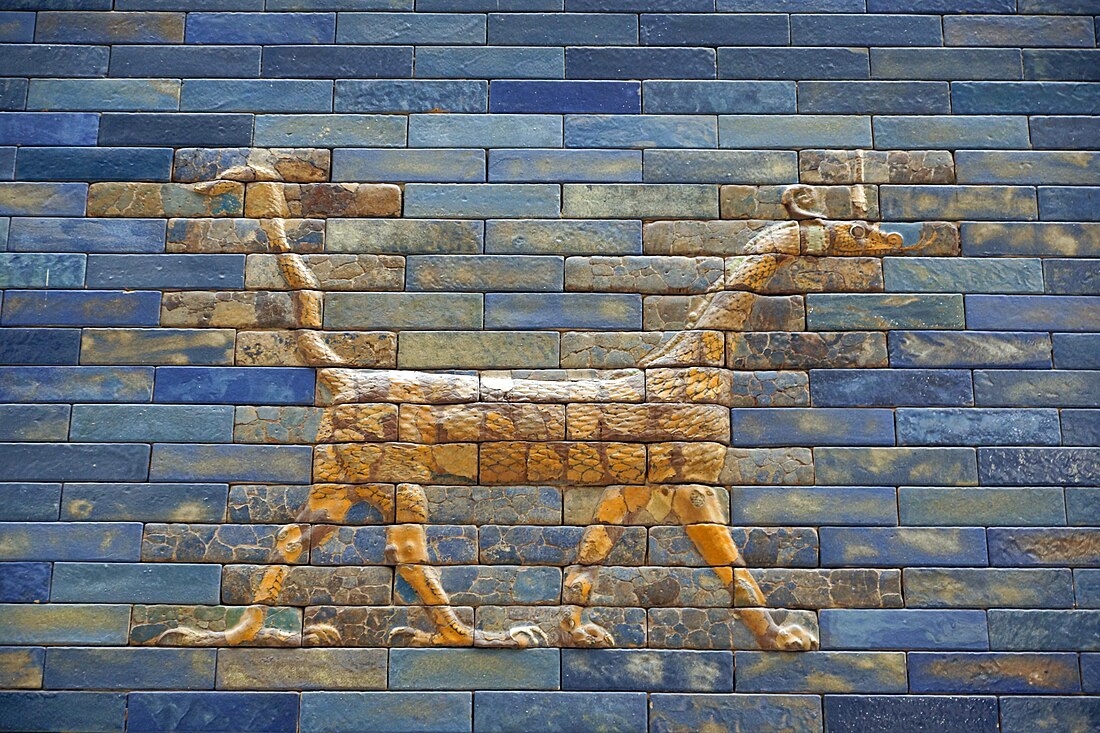Mušḫuššu
Dragon-like creature from Mesopotamian mythology From Wikipedia, the free encyclopedia
The mušḫuššu (𒈲𒍽; formerly also read as sirrušu or sirrush) or mushkhushshu (Akkadian pronunciation: [muʃˈχuʃ.ʃum]) is a creature from ancient Mesopotamian mythology. A mythological hybrid, it is a scaly animal with hind legs resembling the talons of an eagle, lion-like forelimbs, a long neck and tail, two horns on its head, a snake-like tongue, and a crest. The mušḫuššu most famously appears on the Ishtar Gate of the city of Babylon, dating to the sixth century BCE.
 | |
| Grouping | Mythological hybrid |
|---|---|
| Folklore | Babylonian mythology |
| Other name(s) | Sirrush |
| Region | Mesopotamia |

The form mušḫuššu is the Akkadian nominative of Sumerian: 𒈲𒍽 MUŠ.ḪUŠ, 'reddish snake', sometimes also translated as 'fierce snake'.[2] One author,[3] possibly following others, translates it as 'splendour serpent' (𒈲 MUŠ is the Sumerian term for 'serpent'). The older reading sir-ruššu is due to a mistransliteration of the cuneiform in early Assyriology[4] and was often used as a placeholder before the actual reading was discovered.[5]
History
Mušḫuššu already appears in Sumerian religion and art, as in the "Libation vase of Gudea", dedicated to Ningishzida by the Sumerian ruler Gudea (21st century BCE short chronology).[1][6]
The mušḫuššu was the sacred animal of Marduk and his son Nabu during the Neo-Babylonian Empire. The dragon Mušḫuššu, whom Marduk once vanquished, became his symbolic animal and servant.[7] It was taken over by Marduk from Tishpak, the local god of Eshnunna.[8]
The constellation Hydra was known in Babylonian astronomical texts as Bašmu, 'the Serpent' (𒀯𒈲, MUL.dMUŠ). It was depicted as having the torso of a fish, the tail of a snake, the forepaws of a lion, the hind legs of an eagle, wings, and a head comparable to the mušḫuššu.[9][10]
- 9th century BCE depiction of the Statue of Marduk, with his servant dragon Mušḫuššu at his feet. This was Marduk's main cult image in Babylon.
- Head of dragon dating from the Neo-Babylonian Empire (626 BCE – 539 BCE) from the Louvre Museum's collection
See also
References
Notes
External links
Wikiwand - on
Seamless Wikipedia browsing. On steroids.



